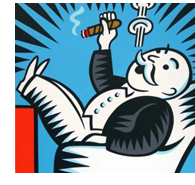“Far from trickling down, income and wealth are instead being sucked upwards at an alarming rate,” a new Oxfam study finds. The Atlantic reports, The World’s Wealthiest 62 People Have as Much Money as the Poorest 3.5 Billion:
 Wealth just keeps growing for the 62 richest people in the world. Collectively, this ultra-wealthy group controls $1.76 trillion, which is about the cumulative worth of the poorer half of the world’s population, or around 3.5 billion people. And since 2010, wealth has become more and more concentrated in favor of the richest of the rich while those on the lower rungs of the economic ladder have seen their positions worsen, according to a new report from Oxfam International.
Wealth just keeps growing for the 62 richest people in the world. Collectively, this ultra-wealthy group controls $1.76 trillion, which is about the cumulative worth of the poorer half of the world’s population, or around 3.5 billion people. And since 2010, wealth has become more and more concentrated in favor of the richest of the rich while those on the lower rungs of the economic ladder have seen their positions worsen, according to a new report from Oxfam International.
The wealth of the richest 62 people grew by more than half a trillion dollars in that last half-decade, while the wealth of the poorest 50 percent of people globally decreased by more than $1 trillion during the same period. “Far from trickling down, income and wealth are instead being sucked upwards at an alarming rate,” the study finds.
The Wealth of the Rich Keeps Climbing


